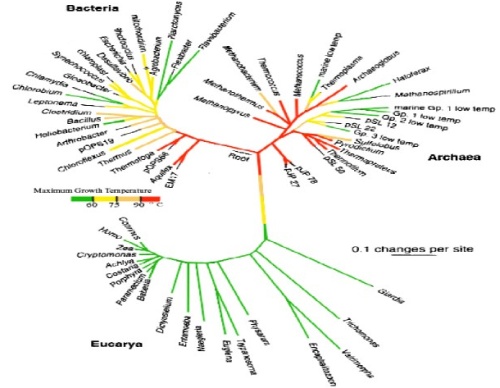Now the physicists know what it was like to be an economist in 1978.
Archive for the 'Science' Category
There are (at least) two ways to test the efficacy of a vaccine. The Stupid Way is to administer the vaccine to, say, 30,000 volunteers and then wait to see how many of them get sick. The Smarter Way is to adminster the vaccine to a smaller number of (presumably much better-paid) volunteers, then expose them to the virus and see how many get sick.
A trial implementing the Smart Way is getting underway at Imperial College London. In the United States, we do things the Stupid Way, at least partly because of the unaccountable influence of a tribe of busybodies who, having nothing productive to do, spend their time trying to convince people that thousands of lives are worth less than dozens of lives. Those busybodies generally refer to themselves as Ethicists, but I think it’s always better to call things by informative names, so I will refer to them henceforth as Embodiments of Evil.
Last night, while I was attempting to calculate the amount of damage that these Embodiments of Evil have caused, I was interrupted by a knock on my door. It turned out to be a man from Porlock, who wanted to consult me on some mundane issue. At first I tried to turn him away, explaining that I was in the midst of a difficult calculation and could not be distracted. But my visitor brought me up short by reminding me that the economist’s job is not just to lament bad policies, it’s also to figure out ways to circumvent them. So we put our heads together and this is what we came up with:
First, design a vaccine trial that is, to all appearances, set up the Stupid Way. We vaccinate people, we let them go their own ways, and we track what happens. But we add one twist: Any volunteer who gets sick after being vaccinated receives an enormous payment. Call it something like “Compassionate Compensation”.
Here are the advantages:
Continue reading ‘Vaccine Testing: The Smart and Sneaky Way’
A short time ago, in a Universe remarkably similar to our own, a team of researchers investigated racial differences in cognitive skills and concluded, with high degrees of certainty and precision, that the correlation between race and intelligence is zero. They submitted their results to a journal called Science, which is remarkably similar to the journal called Science in our own Universe. The paper was accepted for publication, but the editors saw fit to issue this public statement:
We were concerned that the forces that want to downplay the differences between the races as well as the need for racial segregation would seize on these results to advance their agenda. We decided that the benefit of providing the results to the scientific community was worthwhile.
Which of the following best captures the way you feel about that statement?
A. Bravo to the editors for advancing the cause of truth, even if it might be misused.
B. Boo to the editors for even thinking about suppressing the truth, even if the truth might be misused.
C. WHAT?!?!? Since when is a failure to share the editors’ political priorities a “misuse” in the first place?
D. Both B and C.
E. Other (please elaborate).
My vote is for D. It is outrageously wrong for the editors to even consider using the resources of their journal to promote their private political agenda. It is doubly wrong for them to even consider doing so by suppressing a paper they would otherwise accept. And it is triply wrong for them to even consider imposing on the owners and readers of the journal to support a political agenda that some of those owners and readers will no doubt find deplorable.
I happen to be one of those who deplore the expressed agenda, but that has nothing to do with my point here. The outrage would be exactly as great if the editors were focused on protecting capitalism instead of segregation.
Now let’s come back to our own Universe, where the editors of Science (the real Science) accepted a paper suggesting that a large fraction of the population might already have a sort of pre-immunity to Covid 19, and somehow saw fit to issue the following statement:
We were concerned that forces that want to downplay the severity of the pandemic as well as the need for social distancing woud seize on the results to suggest that the situation was less urgent. We decided that the benefit of providing the model to the scientific community was worthwhile.
As I said, the two Universes are eerily similar. The statements made by the editorial boards in both Universes seem about equally outrageous to me.
The real-world editors, if they cared what I thought, might want to respond that my analogy fails because “the need for racial segregation” is a political stance, whereas “the need for social distancing” is a scientific one. If so, they’d simply be wrong. Biologists have no particular insight into whether people would be happier in a world with both a little more Covid and a few more hugs. If any group is uniquely qualified to estimate the terms of that tradeoff, it’s the economists — but I wouldn’t want the editors of an economics journal making this kind of call either.
I’m glad that the editors did the right thing. I’m appalled they even considered doing the wrong thing, and concerned that this means they might do the wrong thing in the future, and might have done so in the past. It is not okay to suppress truth in the furtherance of a political agenda. It is not okay to presume that all good people share in your agenda, or to co-opt other people’s resources in order to advance it.
(Hat tip to David Friedman, whose blog made me aware of this.)
 Every day, a man comes to my door with a United States nickel in his hand. He asks me whether I’d prefer to examine the heads side (which is always painted either black or white) or the tails side (which is always painted either red or green). I choose each day according to my whims.
Every day, a man comes to my door with a United States nickel in his hand. He asks me whether I’d prefer to examine the heads side (which is always painted either black or white) or the tails side (which is always painted either red or green). I choose each day according to my whims.
And the same thing happens to my sister. Different man, different coin, but each day he’s there with a painted nickel, offering to let her examine either the heads side or the tails side.
Sometimes we call each other to compare notes on the colors we’ve seen. Here’s what we’ve concluded:
- Our heads sides are never both white.
- Whenever one of our tail sides is green, the other one’s heads side is white.
We have thousands of observations to support these conclusions: On days when we both examine our heads sides, we never both see white. On days when we examine opposite sides and one sees a green tail, the other always sees a white head.
The Brain Teaser: Today we both chose Tails and both saw green. What colors were on our Heads sides?
Solution: By point 2) above, they were both white. But by point 1) above, that can’t happen. So….?
So what now?
From researchers at Harvard, here is stunning time-lapse photography of something that (as far as I can see) might or might not be evolution. A bacteria colony spreads out across a giant Petri dish, hits an area with a high concentration of antibiotics, appears to be stopped in its tracks, but then slowly breaches the boundary in a limited area and is soon spreading as before until it reaches an area with an even higher concentration of antibiotics, and the story repeats:
According to the narrator, the barrier is being breached by a small number of antibiotic-resistant mutants, which then reproduce like crazy, at least until they come into competition with other mutants, etc. In other words, evolution.
Now I’m sure this is an extremely naive question, but I hope someone can offer an answer that will leave me less naive: How do we know this is evolution as opposed to learned behavior?
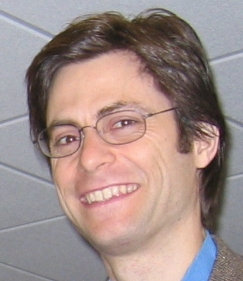 Max Tegmark is a professor of physics at MIT, a major force in the development of modern cosmology, a lively expositor, and the force behind what he calls the Mathematical Universe Hypothesis — a vision of the Universe as a purely mathematical object. Readers of The Big Questions will be aware that this is a vision I wholeheartedly embrace.
Max Tegmark is a professor of physics at MIT, a major force in the development of modern cosmology, a lively expositor, and the force behind what he calls the Mathematical Universe Hypothesis — a vision of the Universe as a purely mathematical object. Readers of The Big Questions will be aware that this is a vision I wholeheartedly embrace.
Tegmark’s new book Our Mathematical Universe is really several books intertwined, including:
- A brisk tour of the Universe as it’s understood by mainstream cosmologists, touching on many of the major insights of the past 2000 years, beginning with how Aristarchos figured out the size of the moon, and emphasizing the extraordinary pace of recent progress. In just a few years, cosmologists have gone from arguing over whether the Universe is 10 billion or 20 billion years old to arguing over whether it’s 13.7 or 13.8.
In yesterday’s post, I claimed to have refuted Richard Dawkins’s claim that everything complex must have emerged from something simple by citing the natural numbers, which are provably highly complex (in a very precise sense) yet did not emerge from something simple. Numerous commenters suggested that I’d been unfair to Dawkins, because he’d surely meant his claim to apply only to biological processes.
Here is a quote from Dawkins’s book “The God Delusion”:
Time and again, my theologian friends returned to the point that there had to be a reason why there is something rather than nothing. There must have been a first cause of everything, and we might as well give it the name God. Yes, I siaid, but it must have been simple and therefore, whatever else we call it, God is not an appropriate name….The first cause that we seek must have been the simple basis for a self-bootstrapping crane which eventually raised the world as we know it into its present existence.
I could provide additional quotes, but this one should suffice. Dawkins believes, unless I have misunderstood him completely, that he has a quite general argument, not tied in any way to biology (because the above quote, for example, has nothing to do with biology) to establish that complex structures must have simple causes. That argument, whatever it might be, cannot be correct because the natural numbers stand as a counterexample.
If Dawkins, or any of his defenders, wants to respond that his argument is not intended to apply to the natural numbers, it becomes incumbent on them to point to a hypothesis which is actually used in the argument which would rule out such an application. Absent such a hypothesis, the argument must be erroneous.
I claim to have explained in The Big Questions exactly how the first cause of our Universe could be a mathematical structure that is far more complex than the Universe itself; of course others, like Max Tegmark, have demonstrated this possibility in far more detail than I have. Whether or not Tegmark and I are correct in our beliefs, I claim we’ve at least demonstrated that (as far as we can tell) those beliefs could be true, which, once again, refutes Dawkins’s position.
An argument that leads to flat-out wrong conclusions cannot be a correct argument, even if some of its implications turn out to be true. So I stand by what I said both yesterday and in The Big Questions : Dawkins’s position fails for exactly the same reason that Michael Behe’s does — we have an explicit example that shows that complexity requires neither a simpler antecedent nor a designer.
Bob Murphy, always my favorite theist, posts a defense of Intelligent Design theory, or at least an attack on its attackers, who, he claims, have largely failed to grasp what the ID theorists, such as Michael Behe, are claiming:
Behe is fine with the proposition that if we had a camera and a time machine, we could go observe the first cell on earth as it reproduced and yielded offspring. There would be nothing magical in these operations; they would obey the laws of physics, chemistry, and biology. The cells would further divide and so on, and then over billions of years there would be mutations and the environment would favor some of the mutants over their kin, such that natural selection over time would yield the bacterial flagellum and the human nervous system.
Yet Behe’s point is that when you look at what this process spits out at the end, you can’t deny that a guiding intelligence must be involved somehow.
(Emphasis added.)
Perhaps Bob has forgotten that I disposed of this argument in Chapter 4 of The Big Questions , with a single counterexample that refutes both Behe and his polar opposite Richard Dawkins in one fell swoop. Let’s recall their positions, stated as simply as possible:
Behe: Irreducible complexity requires an intelligent designer.
Dawkins: Irreducible complexity requires evolution. (This is Dawkins’s stated position in his book The God Delusion.)
Landsburg: The natural numbers are irreducibly complex, moreso (by any reasonable definition) than anything in biology. But the natural numbers were not designed and did not evolve, so Behe and Dawkins are both wrong.
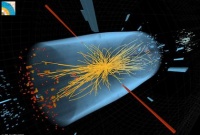 The apparently imminent discovery of the Higgs boson by scientists at CERN will have at least one quirky side effect that appears to have gone entirely unremarked until the appearance of this blog post — it threatens to inflict fatal collateral damage to the brilliant, eccentric and infuriating Omega Point Theory proposed by the physicist Frank Tipler.
The apparently imminent discovery of the Higgs boson by scientists at CERN will have at least one quirky side effect that appears to have gone entirely unremarked until the appearance of this blog post — it threatens to inflict fatal collateral damage to the brilliant, eccentric and infuriating Omega Point Theory proposed by the physicist Frank Tipler.
Tipler, who is not a crackpot, once published a book called The Physics of Immortality, purporting, on the basis of orthodox physics plus some plausible auxiliary assumptions, to establish the existence of an omnipotent, omniscient, omnipresent and altruistic “being” who will one day resurrect everyone who has ever lived to eternal life.
The first step toward that startling conclusion is the assumption that our descendants will not allow all life to come to an end. This in turn will require them to control the evolution of the Universe so that it doesn’t collapse in anything that human beings perceive as a finite amount of time; Tipler argues that they’ll quite plausibly have the technology to do that. But all this future tinkering with the shape of the Universe has consequences that (in a very rough sense) radiate backward and forward through time. From this and some highly technical but more-or-less standard physics, Tipler manages to conclude the existence of an Omega Point — a place where (again speaking roughly) all the information in the Universe is stored. Writing in 1994, Tipler never considered the possibility that the Omega Pont might be located in Mountain View, California. Instead, he stressed that in its omniscience, it’s something very like God.
Continue reading ‘This Particular God, at Least, Appears to Be Dead’
 |
 |
With a hat tip to our occasional commenter Ron….
Remember those faster-than-light neutrinos? The ones that threatened to overturn relativity, and along with it everything we think we know about how the universe works?
Well, it turns out that maybe they weren’t faster than light after all — they might have only appeared to be faster than light because their arrival time was mismeasured. The mismeasurement was (it seems) caused by the researchers’ failure to account for the effects of ….. relativity!
I hear an echo of the great ongoing debate between Einstein and Bohr on the foundations of quantum mechanics. Continue reading ‘Relatively Speaking’
 |
 |
 |
Scientists at CERN have found apparent evidence that neutrinos can travel faster than light.
Suppose that tomorrow historians at Harvard find apparent evidence that the South won the American Civil War — not in some metaphorical “they accomplished their goals” sense, but in the literal sense that it was actually Grant who handed his sword to Lee at Appomatox and not the other way around.
Question: Of which conclusion would you be more skeptical?
Of course your answer might depend on exactly what this new “apparent evidence” consists of. So let me reword: As of this moment, which do you think is more likely — that neutrinos can travel faster than light, or that the South won the Civil War?
I didn’t think anyone would get it. I was completely stumped myself until I got help from my friends. But Neil got it.
In his words, “We have onomatopoeaic words for the sounds made by all of the animals on the right.”
Or, as I prefer to think of it, the animals on the right all have vocabularies (consisting, in most cases, of a single word) while those on the left do not.
A donkey brays, and when it brays it says hee-haw. The donkey makes it to the right of the line not by virtue of braying, but by saying hee-haw. Thus the elephant, which trumpets, but thereby merely makes a noise (as opposed to saying a word) is consigned to the left.
Lions, tigers, and jaguars all roar, but to the best of my recollection from extensive reading (mostly at about age 5), lions and tigers, when roaring, actually say the word “roar”, while a jaguar merely roars incoherently. Chickens say “cheep”. Hens say “buck-buck-buck” (the act of saying this is called “clucking”). Roosters can crow in either of two dialects: Some say “rrr-rr-rrr-rr-rrrrr” while others (who my five-year-old self considered unbecomingly pretentious) say “cock-a-doodle-doo”. Pretentious they may be, but as a scientist, I am here to record the facts, not to judge them.
| I’m not pompous; I’m pedantic. |
| There’s a difference. |
| —The Calligraphic Button Catalogue |
Just about a year ago, a team of scientists reported that Betelgeuse—the bright red star in Orion’s shoulder—appears to have shrunk by about 15% since 1993. That would mean the diameter’s been shrinking at about 1200 miles an hour for all that time.
Such shrinkage—if it’s really happening (it’s hard to be sure)—could be the precursor to a supernova explosion, which would be way cool. The mathematician John Baez computes that a supernova Betelgeuse might be roughly as bright as the full moon, or maybe up to three times as bright.
Surprisingly, it took almost a year for this information to be widely reported on the Internet, but in the past few weeks, a number of sites have cropped up touting the upcoming supernova, and, as you might expect, a few prophecying doom. You can ignore the doomsayers; at a distance of 600 light years, Betelgeuse is too far away to hurt us.
Browsing the various science forums (such as Discover‘s), I’m struck by how often the following simple question comes up: Given that Betelgeuse is 600 light years away, is it or is it not true that it would it would take 600 years for us to notice any explosion? Or to put this another way: If the sky lights up with a new moonlike object tomorrow night, does that mean the explosion took place 600 years ago?
A pretty good answer—and the one that’s being given on all those science forums—is “yes”. But that can’t be exactly right, at least not for all of us, because at any given moment some of us are sitting in our living rooms while others are driving on the Interstates. Relativity tells us that if we’re moving relative to each other, then we must disagree about the times of distant events.
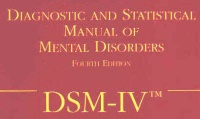 The Diagnostic and Statistical Manual, widely known as the bible of psychiatric medicine, is under revision and the American Psychiatric Association is accepting public comment at a new website.
The Diagnostic and Statistical Manual, widely known as the bible of psychiatric medicine, is under revision and the American Psychiatric Association is accepting public comment at a new website.
Medpage Today reports that the revision has already been changed several times in response to these comments. These include several areas within the Sexual and Gender Identities categories, and modifications to the criteria for adjustment disorders and eating disorders.
By contrast, the American Physical Society is not asking the general public to weigh in on the prospects for supersymmetry, nor is the American Economic Association surveying the general public on the properties of dynamic stochastic general equilibria. So much for any pretense that psychiatry is a science.
Hat tip to Tom Amoroso, who called this to my attention though he might not endorse this commentary.
What are the odds that humankind will survive long enough to colonize the Universe?
Katja Grace argues that the odds are low. Stripped of some nuance, her argument comes down to this:
- The fact that we’re around suggests that intelligent life is likely to be common.
- No other intelligent life appears to have colonized the Universe.
- If they haven’t succeeded, why should we?
By coincidence number one, I discovered Katja’s post (via a ringing endorsement from Robin Hanson) just hours after I’d posted yesterday’s entry here on The Big Questions disputing point 1). Of course, if point 1) fails then so does the entire argument.
This diagram, lifted from a lively paper by the astrobiologist Charles Lineweaver, is the tree of life on earth. The “root” at the center is the last common ancestor of all life. Toward the bottom left, you’ll find the genus “Homo”, to which you and I belong, at the end of a twig representing animals. The two neighboring twigs, ending in Zea (i.e. corn) and Coprimus, represent plants and fungi, our two closest relatives.
Professor Lineweaver offers this diagram as an antidote to the superstition that evolution has some tendency to converge on intelligence; his criterion is that we ought not say that evolution “converges” toward some feature unless we observe that feature arising independently in at least two or more twigs. By that same criterion, evolution has no tendency even to converge on heads, which (says Dr. Lineweaver) are likely to be prerequisite for anything like human intelligence.
If human-like intelligence is a fluke, then presumably the ability to build radio telescopes is also a fluke, which stands as a cautionary note for those who expect to communicate with extraterrestrial civilizations.
Some say the world will end in fire; some say in ice. Paleontologist Peter Ward says the seas could turn to sulfur; physicist Michio Kakutani expects the world (along with the rest of the Universe) to end in a deep freeze—though he holds out hope that we could stay warm by escaping to a parallel Universe. Environmental scientist Stewart Brand foresees a climate catastrophe, astronomer Edward Sion worries about supernovas and asteroid impacts, physicst Melissa Franklin contemplates being swallowed quickly and painlessly by a black hole—which wouldn’t be so bad, she says. Astronomer Robert Kirshner imagines a lonely future back here in the Milky Way after the expansion of the Universe transports the other galaxies beyond our observable horizon. Political scientist Graham Allison imagines destruction by nuclear terrorists, and pretty much everyone agrees that sooner or later the earth will be swallowed by a dying sun.
You can watch the video interviews at BigThink, where, as always, I wish they would post transcripts; reading is faster than viewing and skimming is faster still. But if you’ve got the patience, some of these are fun.
What’s your (realistic or fanciful) scenario for the end of days?
 I love evolutionary biology, so I love this argument: Beauty is more valuable to girls than it is to boys, so beautiful parents should have more daughters than sons. You want (or at least your genes want) to pass on your assets to children who can make the best use of them.
I love evolutionary biology, so I love this argument: Beauty is more valuable to girls than it is to boys, so beautiful parents should have more daughters than sons. You want (or at least your genes want) to pass on your assets to children who can make the best use of them.
So I was delighted by recent news reports that beautiful women do indeed have more daughters. But I was stunned by the reported magnitude of the effect: According to one report, beautiful people are 36 percent more likely to have a daughter than a son!
 Between The Folds is a striking documentary about the art and science of origami. I’ve watched an advance copy, provided by the producers, and it’s really quite mesmerizing. Roughly half the program is devoted to artists like Satoshi Kamiya, who folded this extraordinary dragon, according to the rules of origami, from a single piece of paper with no cuts. In the second half, we meet mathematicians and scientists like Robert Lang,
Between The Folds is a striking documentary about the art and science of origami. I’ve watched an advance copy, provided by the producers, and it’s really quite mesmerizing. Roughly half the program is devoted to artists like Satoshi Kamiya, who folded this extraordinary dragon, according to the rules of origami, from a single piece of paper with no cuts. In the second half, we meet mathematicians and scientists like Robert Lang,
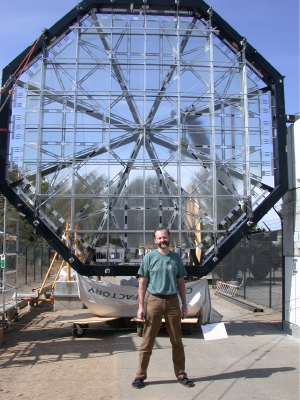 pictured here in front of the folding lens he designed for the Hubbell Space Telescope—folded, it fits inside a small rocket ship for delivery to its destination in space, where it unfolds automatically—and Erik Demaine, the paperfolding enthusiast and Macarthur “genius” award winner who is applying origami to the design of synthetic proteins that fold reliably into the proper configurations.
pictured here in front of the folding lens he designed for the Hubbell Space Telescope—folded, it fits inside a small rocket ship for delivery to its destination in space, where it unfolds automatically—and Erik Demaine, the paperfolding enthusiast and Macarthur “genius” award winner who is applying origami to the design of synthetic proteins that fold reliably into the proper configurations.
“Between the Folds” has its national television debut tomorrow night (Tuesday, December 8 on PBS; check your local listings for the time). Or check here for additional showings.


